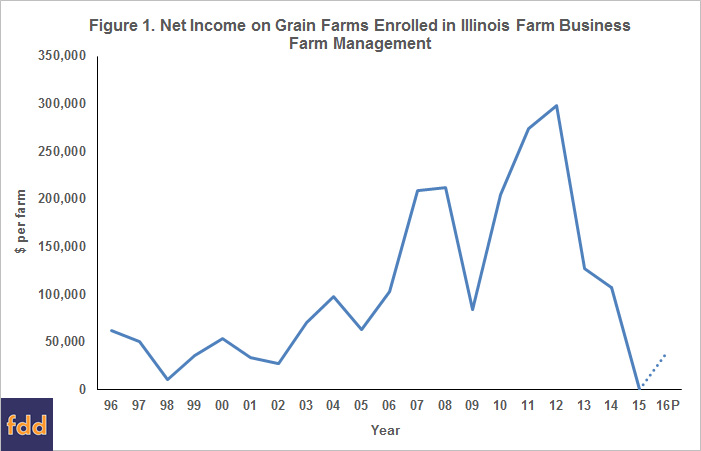2017 Projected Incomes on Illinois Grain Farms
Net incomes for Illinois grain farms are projected lower in 2017 than for 2016. If these projections hold, weakening of financial position will continue in 2017. Trend yields and commodity prices of $3.80 per bushel for corn and $9.90 per bushel for soybeans are used in 2017 projections. Deviations in yields or prices from these assumptions will change 2017 incomes. Net incomes on grain farms likely will remain at low levels as long as corn prices remain below $4.00 per bushel.
Historical Net Incomes on Illinois Grain Farms
Figure 1 shows a history of average net incomes on grain farms enrolled in Illinois Farm Business Farm Management (FBFM). Over time, average farm size has increased. In 2015, the average farm size of farms summarized was about 1,500 acres, with some farms being smaller in size, and some farms being considerably larger in size.

After being at higher levels from 2010 to 2012, net incomes decreased each year from 2012 to 2015. In 2015, net incomes averaged $500 per farm, the lowest level of any year between 1995 and 2015, and well below an income level needed to result in stable financial positions on grain farms. From income, farmers must provide for debt repayments, expansion, and family living. Most farms did not cover these requirements in 2015, resulting in reductions in working capital on most farms.
FBFM has not summarized 2016 net incomes as of yet. As a result, 2016 income still is only a projection. Net income will be higher in 2016 than in 2015, perhaps averaging in the $40,000 to $50,000 range. Several factors contributed to the income increases:
- Decreases in costs and cash rents. Costs decreased in 2016, primarily because of lower fertilizer prices. Also, cash rents decreased slightly.
- Above average yields. Illinois yields were exceptional in 2016. U.S.D.A. reports an average Illinois corn yield of 197 bushels per acre in 2016, 22 bushels higher than the 175 bushel per acre yield in 2015. The 2016 yield is 3 bushels below the all-time high Illinois yield of 200 bushels per acre set in 2014. U.S.D.A. reports a 2016 Illinois soybean yield of 59 bushels per acre, a record high yield besting the previous record yield of 56 bushels per acre yield set in 2014 and 2015.
- Relatively high Agricultural Risk Coverage at the county level (ARC-CO) payments. Many farmers received sizable payments in the fall of 2016 related the 2015 crop. ARC-CO likely will make payments on the 2016 crop, which will be received in 2017. These2016 ARC-CO payments likely will be about half the amount of the 2015 ARC-CO payments, with some farms not receiving any payments.
As usual, farm incomes will range considerably across farms. Those farms that had average yields or below will face considerably lower incomes, as appears to be the case in southern Illinois. Other farms with exceptional yields will have higher incomes,
While higher than 2015 incomes, the projected 2016 incomes do not result in the building of financial reserves on most Illinois farms. Most farms will continue to see erosions of working capital, potentially leading to the need to refinance outstanding operating loan balances.
Net Income in 2017
Net incomes for 2017 are projected using trend-line yields and commodity prices of $3.80 per bushel for corn and $9.90 per bushel for soybeans. These prices are near fall delivery bids for 2017.
Trend-yields and current expectations on commodity prices result in a 2017 income projection that is lower than the average 2016 income, roughly half way between 2015 and 2016 incomes. The 2017 income projection is lower because:
- Yields are projected at trend levels. Much of the reason for higher 2016 incomes were above average yields across much of Illinois.
- ARC-CO payments are projected lower. ARC-CO likely will not make widespread payments on the 2017 crops, unless revenues are markedly lower than projections.
As revenue has declined, costs have been reduced. However, revenue continues to be projected lower each year since 2012. In 2017, lower ARC-CO payments contribute to lower projected revenues.
While projected low, a potential for higher incomes could come if corn prices increase. The $9.90 soybean price used in income projections results in profitable soybean production while the $3.80 corn price results in, at best, break-even levels for corn production. Having corn prices above $4.00 per bushel, which is not that far away from current levels, would lead to improved net incomes on grain farms.
Summary
Given trend yields, net incomes for 2017 continue to be projected low. As long as corn prices are below $4.00 per bushel, incomes on Illinois grain farms will remain low, resulting in continuing erosion of financial positions on many grain farms.
Acknowledgements
The author thanks the local Farm Business Farm Management (FBFM) Associations across the State of Illinois for the use of this data. Without their cooperation, information as comprehensive and accurate as this would not be available. FBFM, which consists of 5,700 plus farmers and 62 professional field staff, is a not-for-profit organization available to all farm operators in Illinois. FBFM field staff provide on-farm counsel with computerized recordkeeping, farm financial management, business entity planning and income tax management. For more information, please contact the State FBFM Office located at the University of Illinois Department of Agricultural and Consumer Economics at 217-333-5511 or visit the FBFM website at www.fbfm.org.
Disclaimer: We request all readers, electronic media and others follow our citation guidelines when re-posting articles from farmdoc daily. Guidelines are available here. The farmdoc daily website falls under University of Illinois copyright and intellectual property rights. For a detailed statement, please see the University of Illinois Copyright Information and Policies here.







